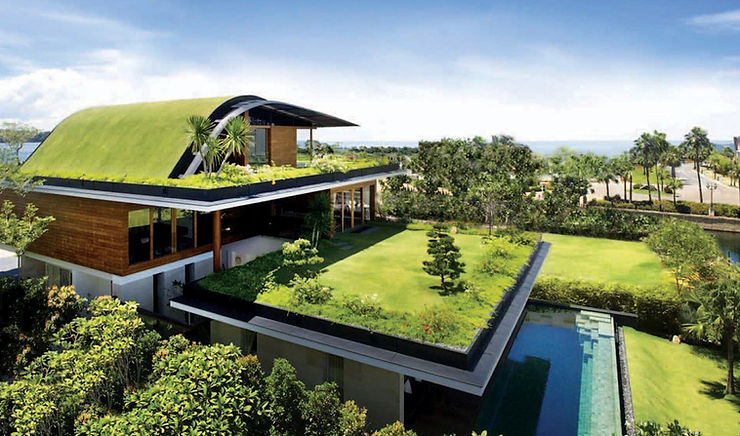Updating your home's roof can be a hefty investment, both visually and financially. It's not just about looks; your roof faces the brunt of the weather and plays a role in regulating your home's temperature. So, when it comes to re-roofing, durability and energy efficiency with Green Roofing Materials take the spotlight.
However, the sustainability angle adds another layer. Truth be told, finding Green Roofing Materials that tick all the boxes for being truly sustainable is quite the challenge.
If your idea of a sustainable roof leans toward a lush green rooftop, there's more to the story. Sustainability in roofing covers a wide spectrum, encompassing various materials.
Choosing eco-friendly roofing involves weighing environmental factors. Price is a big player, too, given that roof shingles can make up about 4 percent of the total costs for a new home. And, of course, aesthetics matter – your roof is a key player in your home's exterior appearance. It's a delicate balance of functionality, environmental impact, and curb appeal.
What Makes a Roof Eco-Friendly?
Energy Efficiency
An environmentally conscious roof assumes a pivotal role in augmenting the energy efficiency of your residence. Its superheroic attributes encompass the adept minimization of heat gains and losses.
This proves to be a transformative influence, particularly when contemplating that an approximate 10-15 percent of a home's thermal loss gracefully dissipates through the roof.
Durability
Envision Green Roofing Materials that exhibit steadfast resilience against an array of challenges, including moisture, wind, and fire.
A roofing system characterized by durability and ecological mindfulness is not merely a protective barrier for your abode; it emerges as a reasonable investment that forestalls premature replacements.
This, in turn, not only conserves natural resources but also alleviates the strain on landfill capacities.
Embodied Energy
This entails a comprehensive spectrum of energy consumption, commencing from the extraction of raw materials to the final delivery of the product.
Picture it as the ecological signature of your roof, encapsulating its environmental impact from its nascent stages to the point of installation.
Recycling and Reusability
The story of eco-friendly roof tiles pivots compellingly as it becomes entwined with the utilization of recycled materials. Moreover, the narrative attains greater profundity as these tiles surpass mere recyclability and prominently demonstrate reusability.
This dual characteristic plays a substantial role in diminishing if not entirely eradicating, landfill waste—a mutually advantageous aspect for the cause of sustainability.
Contribute to a Healthy Ecosystem
In the tale of Green Roofing Materials, eco-friendly options play the hero without causing harm to the ecosystem. From their production to their tenure on your roof, they abstain from releasing toxic chemicals, ensuring a harmonious and eco-friendly coexistence.
Green Roofing Materials and Energy-Efficient Roofing Shingles
Cool Roofs
Cool roofs have gained popularity as an eco-friendly option, incorporating a mixture of white glue and gravel to reflect solar rays. This design reduces heat penetration into the home, thereby lessening reliance on air conditioning and electricity.
However, their efficacy is most pronounced in areas exposed to significant heat and sunlight. It's worth noting that the initial installation cost can be substantial. In regions with high temperatures and humidity, the risk of mold growth exists, potentially impacting the roof's appearance and structural integrity.
Wood Shingles
For those seeking a classic or rustic aesthetic, wood shingles remain a durable and eco-friendly choice. Notably, wood shingles can be recycled into reclaimed wood products, adding to their environmental appeal.
However, factors such as cost, especially in areas without proximity to wood mills, and a relatively limited lifespan of around 15 to 20 years, requiring regular maintenance to prevent issues like rot, mold, and mildew, should be considered.
Metal Roofing
Metal roofing, whether crafted from new or recycled metal, is recognized for its reflective properties that reduce the home's reliance on air conditioning. The versatility of metal Green Roofing Materials is reflected in various alloys and styles.
Despite its popularity as an eco-friendly option, it's essential to acknowledge potential drawbacks, including a higher upfront cost, increased noise during hail storms, and a change in color over time due to weathering.
Clay Tiles
Characterized by a variety of colors and styles, clay tiles stand out as both eco-friendly and energy-efficient.
While they demand additional structural support due to their weight, impacting initial installation costs, clay tiles are relatively low-maintenance, with broken tiles easily replaceable.
Slate Tiles
Slate tiles offer an exceptionally durable and fire-resistant roofing option with an overall eco-friendly design. However, their installation complexity requires experienced professionals and additional structural support is necessary due to their weight.
Solar Roofing
A distinctive and innovative choice, solar roofing can manifest as panels installed on an existing roof or as tiles constituting the roofing itself. While the initial installation cost may be relatively high, the long-term savings on electricity bills make it a cost-effective option.
Solar roofing relies on sunlight availability, limiting its viability to regions with adequate exposure.
Living Roofs
Living roofs present a truly unique and eco-friendly option by transforming rooftops into functional gardens.
While they make a statement and contribute to a longer lifespan, enhanced thermal performance, and improved air quality, their higher setup costs, considering the weight of soil and plants, and maintenance requirements should be considered.
Synthetic Shake Shingles
Synthetic shake shingles, made from materials like polyurethane, are recognized for their durability, fire resistance, and impact resistance.
Beyond these qualities, they contribute to improved insulation, reducing reliance on HVAC systems. Their virtually maintenance-free nature and relative affordability compared to other eco-friendly options make them an attractive choice.
Final Thoughts
Opting for eco-friendly and energy-efficient Green Roofing Materials offers several advantages for your home. Firstly, these environmentally conscious roofing materials tend to exhibit enhanced durability and a longer lifespan, providing a more enduring investment compared to standard roofs.
Beyond their longevity, eco-friendly roofs contribute to environmental kindness and improved energy efficiency. By aiding in temperature regulation within homes, these roofs reduce the dependency on heating and cooling systems, resulting in a more sustainable and energy-conserving solution.


